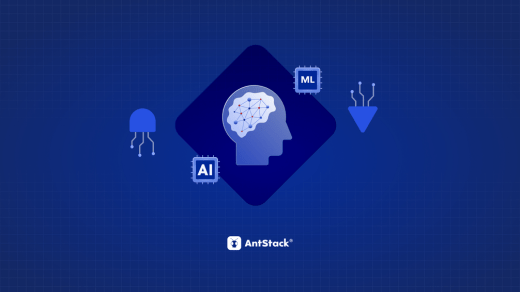Building computer systems that can execute different activities via human intelligence is referred to as artificial intelligence. Such programs imitate human reasoning, human learning, and human decision-making processes. ML or machine learning is considered to be the study of statistical models and algorithms.
They provide an excellent opportunity for computers to seek information from the data, thereby improving performance. The prerequisite combination of machine learning and artificial intelligence helps to improve the software development process. In this section, we are going to talk about the role of artificial intelligence and machine learning in the Tech Stack:
The use of machine learning and artificial intelligence technologies can transform the software development process. Machine learning and artificial algorithms provide developers with excellent options for discovering the latest possibilities in frontend development.
Automated code generation
The use of machine learning and artificial intelligence techniques transforms software development, thereby facilitating automated code generation. Such tools produce code snippets and automate complicated operations. It provides the ideal scope for the developers to write efficient and cleaner code through the latest codebase analysis. Such a process decreases the effort and time necessary for manual coding activities. It is also effective in streamlining the development workflows.
The use of automated code generation, the latest learning patterns, improves the code quality and code consistency. As artificial intelligence takes the prerequisite care of different repetitive coding tasks, the developers can give more focus to removing complex thinking and problem-solving. The use of Artificial Intelligence within software development boosts the innovation rate. It provides a suitable option for programmers to generate more reliable and complex programs.
In the dynamic business landscape of New Zealand, having a reliable and efficient Point of Sale (POS) system is essential for streamlining operations and maximizing profits. A POS system in NZ plays a pivotal role in enhancing customer experience, managing inventory effectively, and staying ahead of the competition. By investing in a quality POS system NZ, businesses can benefit from real-time data insights, improved transaction accuracy, and enhanced overall efficiency. With its user-friendly interface, advanced features, and robust security measures, a POS system in NZ helps businesses of all sizes thrive in today’s digital age.
Provides personalization
Different MI and AI algorithms that utilize deep learning conduct a thorough analysis of user behavior preferences and patterns. They provide the ideal option for full-stack developers to develop personalized experiences. Such developers who make the proper use of techniques like content-based recommendation systems and collaboration filtering systems provide solutions to accomplish the preferences and interests of individual users. The Machine learning model predicts the user behavior, analyzes the needs of the potential user, and adapts the user interface to boost the conversion rates, thereby improving engagement.
Bug fixing and bug detection
After analyzing the historical data and data patterns, the developers look for the bugs, vulnerabilities, and problems in the codebases through different AI-driven technologies. Such a complex evaluation allows the engineers to recognize the issues, thereby facilitating improvement. The development team is known to simplify the processes, thereby dedicating valuable time to solving problems and removing bugs through different AI capabilities in the Serverless Application development process. In addition, the proactive detection of possible risks through different AI-powered solutions improves the development cycle.
Natural Language Processing
The software understands and communicates in human language via NLP or Natural Language Processing techniques. It opens the door to opportunities to develop conversational interfaces, virtual assistants, and chat bots. Such developments improve the user experiences with the streamlining of communication and automation of the customer care choices. NLP techniques are considered to be the best choice for industries like education, healthcare, and customer care. Thus, the NLP techniques redefine human technology interaction via sentiment analysis tools and voice assistants.
Improved decision-making through predictive analytics
Predictive analytics play an integral role in back-end development. It allows the developer to predict future behaviors and future trends depending on historical data. The deep learning tools of machine learning train the predictive models to predict the market trends, demands, and user preferences. It thus helps to improve the decision-making process. Such advanced tools provide the optimum choice for developers to build apps that evolve and adapt to real-time data.
Data security and privacy problems
The proper use of machine learning and Artificial intelligence allows the extensive datasets to go for refinement and training, thereby improving privacy and data security. The developers help to manage the data and fortify different security protocols to secure the confidential information. It introduces stringent measures to handle data, thereby improving the risks and user privacy standards.
With data security, the business enterprise introduces trust among the potential users and improves regulatory needs. In addition, ongoing monitoring and proactive actions are essential to improve AI-driven systems. Besides this, it helps to remove all kinds of potential risks. Awareness is necessary to improve the privacy landscape and data security process, thereby creating the responsible and ethical app of different AI technologies.
Implementation of machine learning and Artificial intelligence in the software development process introduces different benefits. A few of the crucial benefits include improved development speed, cost savings, improved precision, continuous learning, and better scalability. With the automation of tasks, refining user experiences, and improving code quality, such technologies allow developers to create software solutions to meet the changing demands of consumers and businesses.



